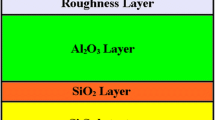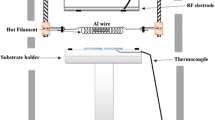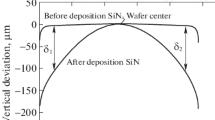Abstract
The influence of film deposition techniques on the thermal boundary resistance of an aluminum (Al)/silicon (Si) interface was investigated in this study. Al films 100 nm in thickness were deposited on Si(100) wafers using an e-beam evaporator and a direct current (DC) magnetron sputtering system. Their microstructural characteristics were inspected using scanning electron microscopy with energy dispersive spectroscopy, atomic force microscopy, and X-ray diffraction. The thermal boundary resistance values of the samples were measured using the time-domain thermoreflectance technique and numerically analyzed based on the transient Fourier heat conduction equation. A non-equilibrium molecular dynamics (MD) study was carried out to understand the effect of the atomic disorder at the film/substrate interface. Results show that the film produced by DC sputtering has a rougher surface than that of the e-beam evaporated one and a higher thermal boundary resistance. This is in agreement with the qualitative trend observed from the MD simulation that showed increases in thermal boundary resistance with the depth of atom intermixing.







Similar content being viewed by others
Abbreviations
- C p :
-
Specific heat
- G :
-
Thermal boundary resistance
- I 0 :
-
Laser intensity
- N :
-
Number of atoms
- R :
-
Reflectance
- T :
-
Temperature
- W :
-
Laser heating function
- d :
-
Film thickness
- k B :
-
Boltzmann constant
- i :
-
Index of atom
- m :
-
Mass
- q :
-
Heat flux
- r RMS :
-
Root mean square roughness
- t :
-
Time
- v :
-
Velocity
- z :
-
Distance in the film thickness direction
- β :
-
Absorption depth
- κ :
-
Thermal conductivity
- λ :
-
Wavelength
- ρ :
-
Density
- τ :
-
Pulse width
References
Fair, R. B. (2012). Rapid thermal processing: Science and technology. Cambridge: Academic Press.
Pop, E. (2010). Energy dissipation and transport in nanoscale devices. Nano Research, 3(3), 147–169.
Schmidt, A. J., Cheaito, R., & Chiesa, M. (2010). Characterization of thin metal films via frequency-domain thermoreflectance. Journal of Applied Physics, 107(2), 024908.
Bordo, K., & Rubahn, H.-G. (2012). Effect of deposition rate on structure and surface morphology of thin evaporated al films on dielectrics and semiconductors. Materials Science, 18(4), 313–317.
Cahill, D. G. (1990). Thermal conductivity measurement from 30 to 750 K: The 3ω method. Review of Scientific Instruments, 61(2), 802–808.
Hatta, I., Sasuga, Y., Kato, R., & Maesono, A. (1985). Thermal diffusivity measurement of thin films by means of an AC calorimetric method. Review of Scientific Instruments, 56(8), 1643–1647.
Murphy, J., & Aamodt, L. (1980). Photothermal spectroscopy using optical beam probing: Mirage effect. Journal of Applied Physics, 51(9), 4580–4588.
Li, W., & Cho, Y. (2014). Thermal fatigue damage assessment in an isotropic pipe using nonlinear ultrasonic guided waves. Experimental Mechanics, 54(8), 1309–1318.
Li, W., Cho, Y., Lee, J., & Achenbach, J. D. (2013). Assessment of heat treated Inconel X-750 alloy by nonlinear ultrasonics. Experimental Mechanics, 53(5), 775–781.
Son, J. M., Lee, J. H., Kim, J., & Cho, Y. H. (2015). Temperature distribution measurement of Au micro-heater in microfluidic channel using IR microscope. International Journal of Precision Engineering and Manufacturing, 16(2), 367–372.
Cahill, D. G. (2004). Analysis of heat flow in layered structures for time-domain thermoreflectance. Review of Scientific Instruments, 75(12), 5119–5122.
Smith, A. N., & Norris, P. M. (2001). Influence of intraband transitions on the electron thermoreflectance response of metals. Applied Physics Letters, 78(9), 1240–1242.
Kim, B. (2013). Interface thermal resistance modeling of the silicon-argon interface. International Journal of Precision Engineering and Manufacturing, 14(6), 1023–1028.
Vo, T. Q., & Kim, B. (2015). Interface thermal resistance between liquid water and various metallic surfaces. International Journal of Precision Engineering and Manufacturing, 16(7), 1341–1346.
Frenkel, D., Smit, B., Tobochnik, J., McKay, S. R., & Christian, W. (1997). Understanding molecular simulation. Computers in Physics, 11(4), 351–354.
Ikeshoji, T., & Hafskjold, B. (1994). Non-equilibrium molecular dynamics calculation of heat conduction in liquid and through liquid-gas interface. Molecular Physics, 81(2), 251–261.
Plimpton, S. (1995). Fast parallel algorithms for short-range molecular dynamics. Journal of Computational Physics, 117(1), 1–19.
Richardson, C., Ehrlich, M., & Wagner, J. (1999). Interferometric detection of ultrafast thermoelastic transients in thin films: Theory with supporting experiment. Journal of the Optical Society of America B, 16(6), 1007–1015.
Billings, B. H., Bleil, D. F., Gray, D. E., & American Instute of Physics. (1972). American institute of physics handbook. New York: McGraw-Hill.
Müller-Plathe, F. (1997). A simple nonequilibrium molecular dynamics method for calculating the thermal conductivity. The Journal of Chemical Physics, 106(14), 6082–6085.
Yang, N., Luo, T., Esfarjani, K., Henry, A., Tian, Z., Shiomi, J., et al. (2015). Thermal interface conductance between aluminum and silicon by molecular dynamics simulations. Journal of Computational Theoretical Nanoscience, 12(2), 168–174.
Jelinek, B., Groh, S., Horstemeyer, M. F., Houze, J., Kim, S.-G., Wagner, G. J., et al. (2012). Modified embedded atom method potential for Al, Si, Mg, Cu, and Fe alloys. Physical Review B, 85(24), 245102.
Arshi, N., Lu, J., Lee, C. G., Yoon, J. H., Koo, B. H., & Ahmed, F. (2013). Thickness effect on properties of titanium film deposited by DC magnetron sputtering and electron beam evaporation techniques. Bulletin of Materials Science, 36(5), 807–812.
Stojanovic, N., Yun, J., Washington, E. B., Berg, J. M., Holtz, M. W., & Temkin, H. (2007). Thin-film thermal conductivity measurement using microelectrothermal test structures and finite-element-model-based data analysis. Journal of Microelectromechanical Systems, 16(5), 1269–1275.
Hopkins, P. E. (2013). Thermal transport across solid interfaces with nanoscale imperfections: Effects of roughness, disorder, dislocations, and bonding on thermal boundary conductance. ISRN Mechanical Engineering, 2013, 682586.
Hopkins, P. E., Norris, P. M., Stevens, R. J., Beechem, T. E., & Graham, S. (2008). Influence of interfacial mixing on thermal boundary conductance across a chromium/silicon interface. Journal of Heat Transfer, 130(6), 062402.
Acknowledgements
This research was supported by the National Research Foundation of Korea funded by the Korean government (Ministry of Science & ICT, Grant No. 2015R1C1A1A01053635).
Author information
Authors and Affiliations
Corresponding author
Additional information
Publisher's Note
Springer Nature remains neutral with regard to jurisdictional claims in published maps and institutional affiliations.
Rights and permissions
About this article
Cite this article
Suk, M.E., Kim, Y.Y. Influence of Deposition Techniques on the Thermal Boundary Resistance of Aluminum Thin-Films. Int. J. Precis. Eng. Manuf. 20, 1435–1441 (2019). https://doi.org/10.1007/s12541-019-00160-7
Received:
Revised:
Accepted:
Published:
Issue Date:
DOI: https://doi.org/10.1007/s12541-019-00160-7




